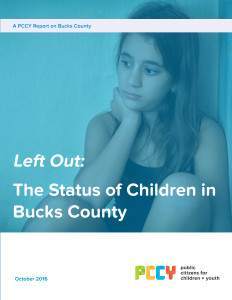Children Still in Recession in Delaware County Despite Recovery
Rising child poverty and lower student achievement casts shadow over modest gains
 Philadelphia (Oct 17, 2016) – While recent headlines tout a national recovery from the Great Recession, more children in Bucks County are facing hardships than during the depths of the recession, a new study has found.
Philadelphia (Oct 17, 2016) – While recent headlines tout a national recovery from the Great Recession, more children in Bucks County are facing hardships than during the depths of the recession, a new study has found.
Public Citizens for Children and Youth [PCCY] announced new comprehensive reports on the status of children in Delaware, Montgomery, Bucks and Chester counties, entitled, “Left Out.” The Bucks County report, the second of the series, was released today.
“An American tragedy is happening right before our eyes, yet it’s very hard to see. The headline news touts a strong economic recovery, and monthly jobs reports amplify that message. But PCCY dug into the data and in Bucks County found a very different and alarming story that does not bode well for children or the county,” said Donna Cooper, Executive Director of Public Citizens for Children and Youth.
The new PCCY “Left Out” series unveils a Child Wellness Index that measures if children are worse off or better with respect four domains: K-12 education, early childhood education, health and economic well-being. Compared to 2008 when the recession was just beginning, in two Child Wellness Index domains – economic well-being and K-12 education – children in Bucks County are faring worse. For early childhood education their situation has not improved, while their health status has improved considerably.
“It’s pretty startling that in nine of the 16 Index measures, children were faring worse in Bucks County compared to 2008. Even where children are doing better, thousands of children are up against very bad odds,” said Cooper.
Economic Rebound Still Not Reaching Children
“We are seeing more formerly middle class breadwinners in Bucks County who have been battered by the recession and now need help to rebuild their skills so they can achieve lasting economic self sufficiency.” – Tam St. Claire, President of Bucks County Women’s Advocacy Coalition
- Five years after the recession (2015), Bucks County had a child poverty rate of 7.3%, or 9,583 children, still higher than the 6.2% at the start of the recession.
- Among the children in poverty, 6,300 are living in families earning less than half of the poverty level ($10,000 or less per year for a family of three), the highest level on record for the county and more than double the number in 2012.
Most School Districts Have Less Funds Even With More Students Who Need Extra Help
“As a third term elected school director, I’ve had to make difficult decisions over the last decade. We have very good schools and great teachers. We can’t provide necessary resources because our state is at the bottom when it comes to the portion of costs for public education coming from the state. Underfunding requires local school boards to choose between cuts to academics, athletics and the arts, or; increasing taxes. I don’t like placing that burden on my neighbors, especially those on fixed incomes. But my first responsibility is to our students. I always hope our community will support serving our children.” – Mark Miller, Centennial School District Board Member
- By 2015, Bucks County school districts overall were spending almost $7,700 less per classroom than in 2008, the largest spending decline of any suburban county. Meanwhile, the disparity in instructional spending between the highest wealth (New-Hope Solebury) and lowest wealth (Bristol Borough) districts jumped to nearly $107,000 per classroom.
- As a result, student performance declined. More than 7,800 third through eighth grade public school students could not pass state reading assessments in 2014, a full 19.4% of students in the county. This fail rate is one point higher than in 2008. The fail rate for math also grew from 2008-2014, pushing it to 15.9%.
Access to Quality Early Learning Experiences Improved, But Most Poor Children Still Not Given this Smart Star
“Continuing to reach underserved children is a major goal. As the saying goes, ‘A hundred years from now… it will not matter what my bank account was, the sort of house I lived in, or the kind of car I drove…but the world may be different because I was important in the life of a child.’ Engaging parents, policy makers and the community in supporting this vision is essential to continuing progress.” – Pat Miiller, Coordinator for the Bucks County Quality Child Care Coalition
- Young families are struggling with the rising costs of child care in Bucks County, where three out of four children under six years old have all parents in the workforce. Full-time childcare for two children (a preschooler and an infant) totaled over $24,000, or nearly a third of the county’s median household income.
- More children in publicly subsidized child care were in high quality programs in 2014 compared to 2008, but still three out of four cannot get access to those programs due to shortages in public funds. Meanwhile fewer children were able to enroll in publicly funded pre-k, with 80% of eligible children in the county unable to enroll in high quality pre-k due to lack of public funding.
The Health Status of Children Made Greatest Gains, but the Poorest Children Show Real Signs of Trouble
- The strongest public policy that protected children during the recession was the availability of state and federally subsidized health care coverage for children. In spite of job losses and cuts to employee benefit packages during the recession, the share of children insured rose a point from 2008 to 2014 to 98% thanks to CHIP and Medicaid. Still, approximately 3,150 children are uninsured, and many of them don’t have the option to enroll in publicly subsidized programs because of the state’s ban on undocumented children’s access to such health care supports.
- Racial health disparities are becoming more dramatic. In 2015, 27% of white children were obese, while the rate for black children was a whopping 2.5 times higher at 71%. Likewise, 6% of white children did not see a dentist in 2015 compared to 26% of black children.
Public Policy Helped Reduce Senior Poverty but Didn’t Do So for Children
- In every county, the economic recession affected thousands of children and seniors, increasing the numbers in poverty at its low point. But unlike seniors, where effective public policies helped them recover more quickly in every suburban county, children were not afforded the same protections. These policies include Medicare, Social Security, Pennsylvania State Prescription Coverage (PACE), Pennsylvania Property Tax and Rent Rebates and state tax policies that exclude retirement earnings from state taxation.
- From 2008 to 2015, the child poverty rate has been about 2% higher on average than the senior poverty rate in Bucks County. In 2013, the senior poverty rate began to decline, a full year earlier than the child poverty rate.
“These reports show good public policies are highly effective at changing life outcomes for children—in many instances they are the only tools that make a difference,” said Cooper. “Elected officials and their constituents have the opportunity to build the public will to adopt policies that protect children and strengthen the prospects of Bucks County.”
Policy Recommendations
- Boost Job Longevity and Pay: Increase the minimum wage and implement workforce supports including predictable scheduling and paid sick and family leave.
- Increase Household Income: Connect families to federal income and work supports like the Earned Income Tax Credit, Child Tax Credit and SNAP.
- Feed Hungry Children: Expand participation in the school meals program.
- Ensure Health Care Access: Expand public health insurance to undocumented children.
- Eliminate Child Lead Poisoning: Ensure that publicly funded health providers test every child under three; remediate homes of pregnant women at high risk for lead hazards.
- Increase School Attendance: Improve how public health providers address asthma, including home visits to reduce home-based asthma triggers.
- Cut the Teen Pregnancy Rate Further: Increase access to long acting birth control for teens with Medicaid.
- Expand the Reach of Early Intervention: Expand the use of early screening tools to identify all children in need of early intervention services.
- Make Quality Child Care Affordable: Use state and county resources to incentivize providers to improve quality and enable providers that are already high quality to expand.
- Expand Pre-K: Increase state investment in pre-k to create a seat for every eligible child.
- Grow Access to Full Day Kindergarten: Remove financial barriers that limit school districts’ ability to provide full day kindergarten.
- Address the School Funding Crisis: Increase state funds for public schools and distribute those funds through the Basic Education Funding Formula.
Links and Graphics
See the full Bucks County report at: https://www.childrenfirstpa.org/wp-content/uploads/2016/10/Left-Out_Bucks-County.pdf
See and share Bucks County indicator graphics at: https://www.childrenfirstpa.org/resource/left-bucks-county-indicators/
See reports from all five counties at: https://www.childrenfirstpa.org/report/left-regional-reports-child-well/
